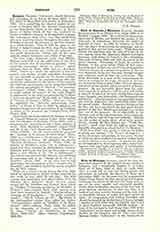

Ruiz de Montoya, ANTONIO, one of the most distinguished pioneers of the original Jesuit mission in Paraguay, and a remarkable linguist; b. at Lima, Peru, on June 13, 1585; d. there April 11, 1652. After a youth full of wild and daring pranks and adventures he entered the Society of Jesus on November 1, 1606. In the same year he accompanied Father Diego Torres, the first provincial of Paraguay, to this mission, where he labored for thirty years as one of its most capable and successful apostles. Father Ruiz de Montoya was one of the true type of great Spanish missionaries of that era, who, as if made of cast-iron, united a burning zeal for souls with an incredible fewness of wants and great power of work. In cooperation with Fathers Cataldino and Mazeta he founded the Reductions of Guayra, brought a number of wild tribes into the Church, and is said to have baptized personally 100,000 Indians. As head of the missions he had charge from 1620 of the “reductions” on the upper and middle course of the Parana, on the Uruguay, and the Tape, and added thirteen further “reductions” to the twenty-six already existing. When the missions of Guayra were endangered by the incursions of marauders from Brazil in search of slaves, Father Mazeta and he resolved to transport the Christian Indians, about 15,000 in number, to the Reductions in Paraguay, partly by water with the aid of seven hundred rafts and numberless canoes, and partly by land through the mazes of the primeval forest. The plan was successfully carried out in 1631 after the suffering of incredible hardships and dangers. “This expedition”, says the Protestant von Ihering, “is one of the most extraordinary undertakings of this kind known in history” [Globus, LX (1891), 179]. In 1637 Montoya on behalf of the governor, of the Bishop of Paraguay, and of the heads of the orders laid a complaint before Philip IV as to the Brazilian policy of sending marauding expeditions into the neighboring regions. He obtained from the king important exemptions, privileges, and measures of protection for the Reductions (see Reductions of Paraguay). Soon after his return to America Montoya died in the odor of sanctity.
He was a fine scholar in the beautiful but difficult language of the Guaraní Indians, and has left works upon it which were scarcely exceeded later. These standard works are: “Tesoro de la lengua guaraní” (Madrid, 1639), a quarto of 407 pages; “Arte y vocabulario de la lengua guaraní” (Madrid, 1640), a quarto of 234 pages; “Catecismo de la lengua guaraní” (Madrid, 1648), a quarto of 336 pages. Mulhall calls Ruiz de Montoya’s grammar and vocabulary “a lasting memorial of his industry and learning’. The German linguist Von der Gabelentz regarded them as the very best sources for the study of the Guarani language, while Hervas declares that the clearness and comprehensive grasp of the rules to which Montoya traced back the complicated structure and pronunciation of Guarani are most extraordinary. All three works were repeatedly republished and revised. In 1876 Julius Platzmann, the distinguished German scholar in native American languages, issued at Leipzig an exact reprint of the first Madrid edition of this work “unique among the grammars and dictionaries of the American languages”. A Latin version was edited by the German scholar Christ. Friedr. Seybold at Stuttgart in 1890-91. A collected edition of all Montoya’s works was published at Vienna under the supervision of the Vicomte de Porto Seguro in 1876. Of much importance as one of the oldest authorities for the history of the Reductions of Paraguay is Montoya’s work, “Conquista espiritual hecha por los religiosos de la C. de J. en las provincial del Paraguay, Paranà, Uruguay y Tape” (Madrid, 1639), in quarto; a new edition was issued at Bilbao in 1892. In addition to the works already mentioned Montoya wrote a number of ascetic treatises. Letters and various literary remains of Ruiz de Montoya are to be found in the “Memorial histor. español”, XVI (Madrid, 1862), 57 sqq.; in “Litterae annuae provinc. Paraguariae” (Antwerp, 1600), and in the “Memorial sobre límites de la Repúbl. Argentina con el Paraguay” (Buenos Aires, 1867), I, appendix; II, 216-252; cf. Backer-Sommervogel, “Bibl. de la C. de Jésus”, VI, 1675 sqq.
ANTHONY HUONDER

